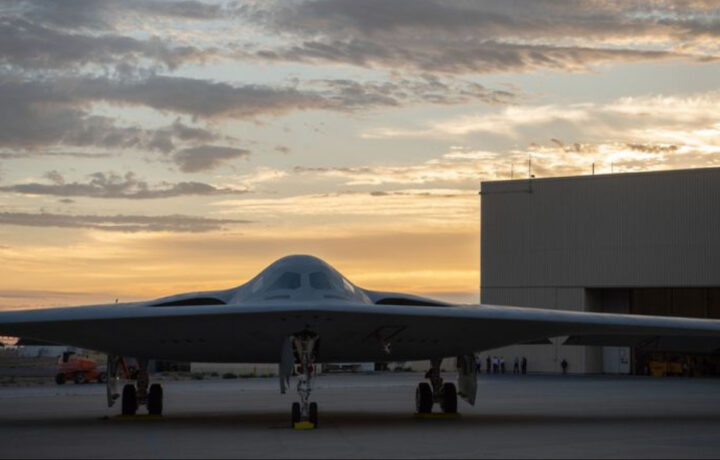The United States Air Force came one step closer to modernizing its bomber fleet on Friday, as the Northrop Grumman B-21 Raider successfully took its first test flight on in Palmdale, CA where the bomber is currently undergoing testing.
The Air Force had previously announced that advanced notice wouldn’t be given as to when exactly the first flight would occur, but the Raider had been undergoing taxi tests – and there was a chance its maiden flight could have occurred unexpectedly. That happened with the General Dynamics F-16 Fighting Falcon nearly 50 years ago when it became airborne during a high-speed taxi test, a critical step toward an aircraft’s first flight.
Though the service also didn’t publicize the event, about three dozen aviation enthusiasts and others gathered around Plant 42 and witnessed the flying wing-styled bomber take to the skies.
B-21 RAIDER FIRST FLIGHT 11-10-23 #RAIDER33 #B21Raider pic.twitter.com/3tEKudqDiw
— Matt Hartman (@ShorealoneFilms) November 10, 2023
“The B-21 Raider is in flight testing,” Air Force spokeswoman Ann Stefanek confirmed via a statement. “Flight testing is a critical step in the test campaign managed by the Air Force Test Center and 412th Test Wings B-21 Combined Test Force.”
Less Than a Year Since Debut
It has been just over 11 months since the aerospace and defensive contractor officially unveiled the B-21 Raider – the first new strategic bomber to be unveiled in a generation and the first since the Northrop Grumman B-2 Spirit made its public debut back in November 1988.
While similar in appearance to the B-2, the Raider is actually a generational leap in aircraft technology and development.
The Raider was developed to be the multifunctional backbone of the modernized bomber fleet, gradually replacing the aging Rockwell B-1 Lancer and B-2 Spirit bombers now in service. A dual-capable penetrating strike stealth aircraft, the B-21 will be capable of delivering both conventional and nuclear munitions.
Six prototype aircraft are in various stages of production, and they are being built on the same lines, using the same tools and processes that will build the eventual production aircraft. This approach has enabled production engineers and technicians to capture lessons learned and apply them directly to follow-on aircraft, driving home a focus on repeatability, producibility, and quality.
In addition to building a bomber with state-of-the-art technology and capabilities, Air Force officials have further emphasized the focus on containing costs while simultaneously allowing for maximum flexibility. The B-21 has been noted for being designed with an open systems architecture that would enable rapid future capability integration to keep pace with the highly contested threat environment.
Some 8,000 employees of Northrop Grumman and various other defense contractors of all sizes, spread across 40 states, have been secretly building the Air Force’s new stealth bomber. Great efforts have been taken to prevent China and other potential adversaries from gaining access to its technology.
Honoring the Doolittle Raiders
Northrop Grumman was awarded the contract to produce the next-generation bomber in 2015, and the company quickly assembled a nationwide team to design, test, and build the B-21. The Raider – named for the 80 men who took part in the World War II “Doolittle Raid” on Tokyo in the spring of 1942 – was developed using the aerospace firm’s pioneering digital engineering practices and advanced manufacturing techniques together.
The Raider is one part of the U.S. Department of Defense’s (DoD’s) efforts to modernize all three legs of America’s nuclear triad – which also silo-launched nuclear ballistic missiles and submarine-launched warheads.
To that end, the U.S. Air Force plans to buy at least 100 of the aircraft, which as noted will replace the Lancer and Spirit bombers; while the B-21 Raider will operate alongside the Boeing B-52 Stratofortress in the coming decades. Though that bomber is older than the B-1 and B-2, those aircraft were pushed hard during conflicts following the Cold War including in Afghanistan and Iraq.
Northrop Grumman has dubbed the aircraft the first “sixth generation” aircraft as it can easily connect with other aircraft and integrate with future weapons.




